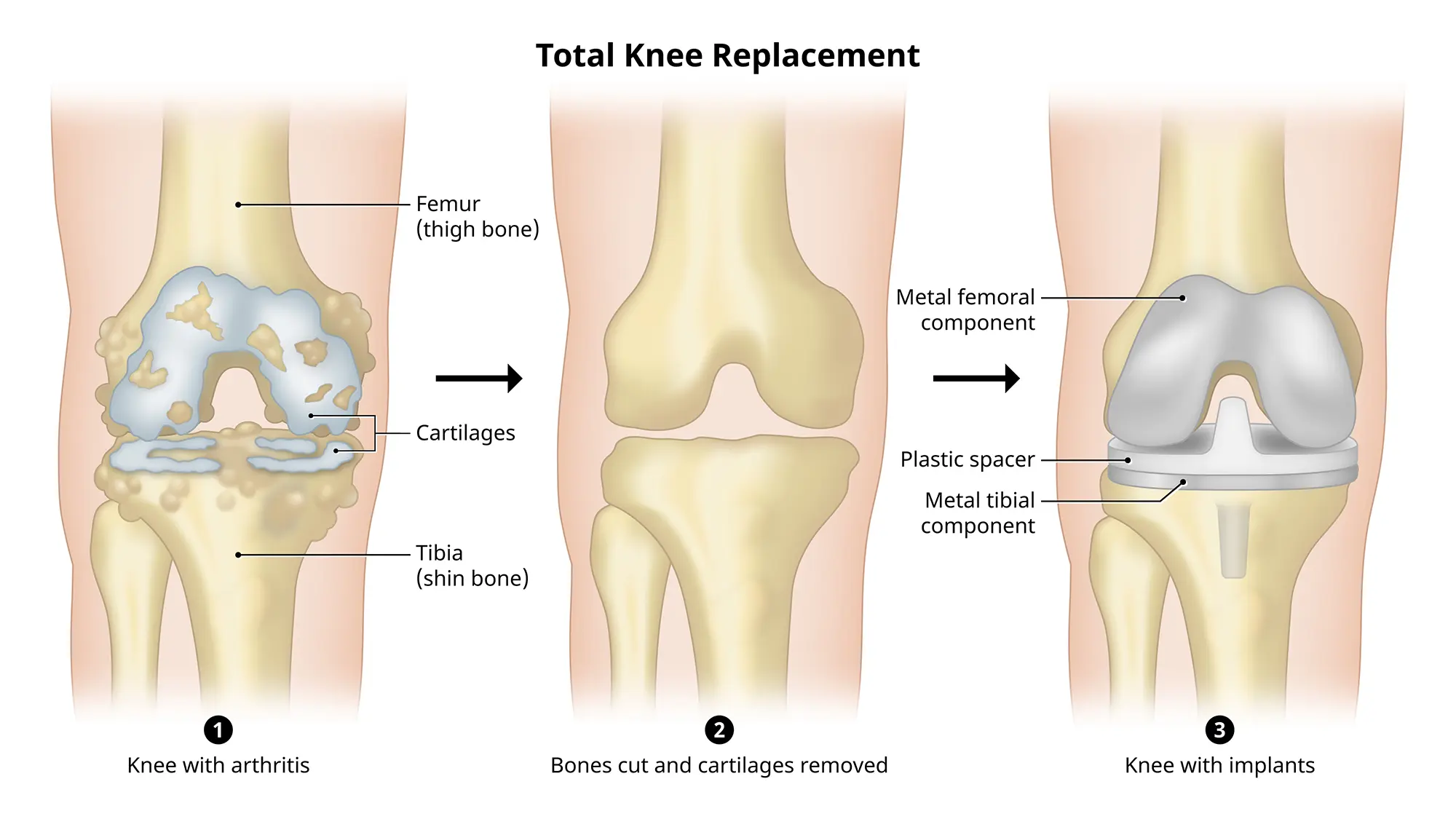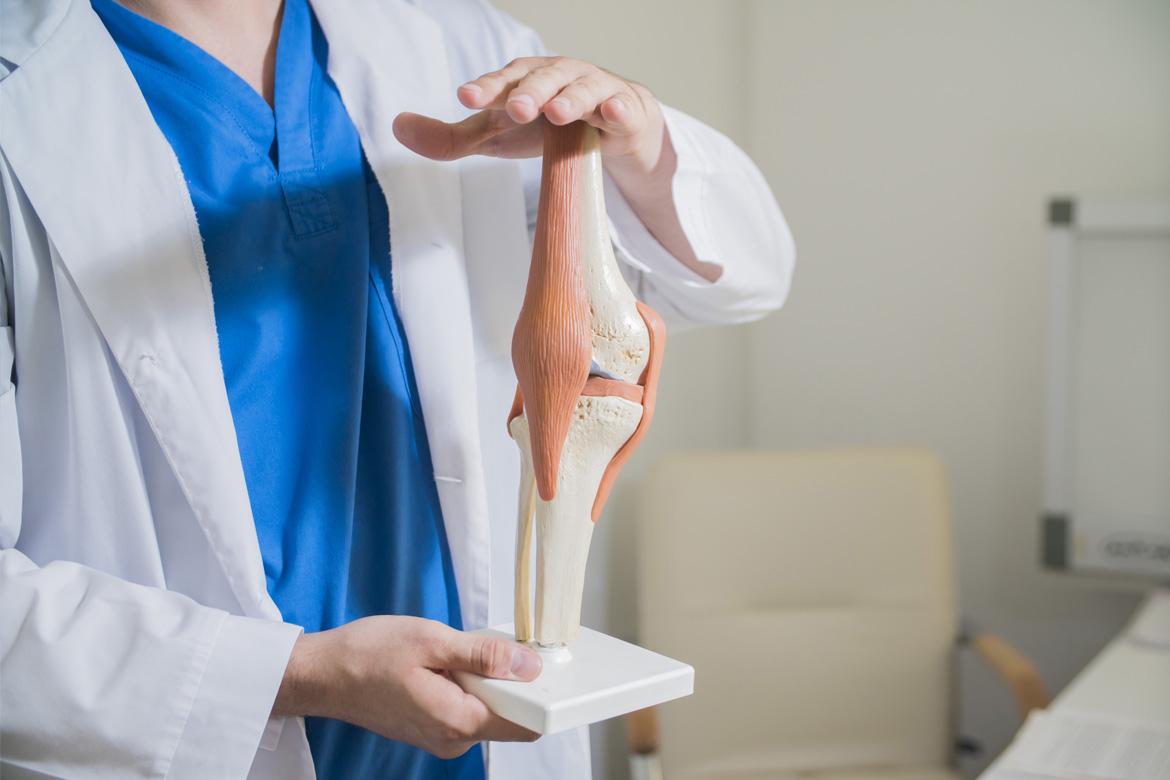What is an arthroplasty (knee replacement)?
Knee arthroplasty, or artificial total knee replacement, is a procedure to replace the arthritic (diseased) parts of the joint with artificial joint components (usually the surfaces of the ends of bones).
Knee pain caused by arthritis can severely affect your ability to lead an active life. Knee arthroplasty is becoming an increasingly common way of treating the condition in older people and in those with severe arthritis or knee injury.
If your doctor recommends knee arthroplasty as a treatment, it is helpful for you to know the anatomy of the knee to understand which parts will be affected by the surgery. The knee joint is made up of:
- Tibia or shinbone – links your knee to the ankle
- Femur or thighbone – connects your hip to your knee
- Patella or kneecap – a small bone in front of the knee, which supports the smooth movement of the knee as it flexes or extends and protects the anterior surface of the knee joint
The articular cartilage – the smooth surfaces at the end of the femur and the end of the tibia – are the ones that get damaged when arthritis occurs.
How it works
In a total knee replacement procedure, the damaged end of the femur and end of the tibia are removed and replaced with prosthesis, an artificial part made from metal and plastic.
A plastic button may also be placed under the kneecap if the kneecap is also damaged. Likewise, the ligament that stabilises each side of the knee joint is either retained or replaced with a polyethylene post.

Why do you need a knee arthroplasty?
If you still experience pain after trying all other arthritis treatments, your doctor may recommend a total knee replacement.
The goal of the surgery is to allow you to resume your normal activities with less pain and greater freedom of movement.
The main reason for replacing any arthritic joint with an artificial joint is to stop the bones from rubbing against each other and causing pain. Replacing the painful arthritic joint with an artificial joint gives the bones new surfaces, which move smoothly without causing pain.
The reasons for getting a total knee replacement include:
- Osteoarthritis
- Rheumatoid arthritis
- Deformities like bowed legs
- Osteonecrosis of the knee – disrupted blood supply to a section of bone in the femur or tibia
- Other knee injuries
How do you prepare for a knee arthroplasty?
Knee arthroplasty is recommended when all the other treatment options have not been successful in resolving your knee problems. Total knee replacement is a major surgery that you need to prepare for.
Prior to surgery, your orthopaedic surgeon will evaluate if a total knee replacement is the best treatment for your condition based on the results of a series of tests which include:
- Medical history – During your check-up, your doctor will ask about your ongoing medications and health history
- Physical examination – Your doctor will evaluate the movement and stability of your knee as well as the overall leg alignment
- X-ray / Ultrasound / Computerised Tomography (CT scan) / Magnetic Resonance Imaging (MRI) – The results of these tests will be your doctor's guide in determining the extent of knee damage
- Other tests like blood test, urine test and electrocardiogram
Your doctor may recommend that you stop taking some medications and supplements before your surgery. You will also be asked not to eat anything for 8 hours before your surgery.
You also need to prepare your home environment for your surgery recovery:
- Set up secure handrails in your bathroom and along stairways
- Put a stable chair in the shower area where you can sit while bathing
- Prepare a comfortable and stable chair with two arms, a back, and a footstool
What can you expect for a knee arthroplasty?
Estimated duration
These days, a total knee replacement surgery can be an outpatient procedure that takes around 1 – 2 hours. However, there are some cases wherein a hospital stay for 1 – 4 days will be required.
During the procedure
Before the surgery, an intravenous line (IV) will be inserted into your vein to give you fluids and medicines. You will be given either a general anaesthesia or a spinal/epidural anaesthesia.
There are different ways to do the surgery. Your doctor may opt to make a cut in the front of your knee to remove the damaged surfaces of the thigh bone and shin as well as the parts of the joint. Afterwards, the orthopaedic surgeon will replace it with the artificial parts.
If your doctor opts to perform a minimally invasive surgery, a shorter cut will be made in the front of your knee. This type of surgery will lessen the damage to your muscle and tendon.
After the procedure
After surgery, you will need to stay in the recovery room for 1 – 2 hours for observation. Once your pulse, breathing and blood pressure are stable, you will either be brought to your hospital room or you will be allowed to go home.
You will need assistance when walking and it will be necessary to have a companion with you at all times time.
You will also temporarily need to use crutches, a walker or a cane to help you with mobility.
Care and recovery after a knee arthroplasty
Within a month, you can expect to have decreased pain and improved flexibility within a month. Your progress will depend on your post-surgery activities, including exercises for your knee to strengthen the muscles and avoid swelling.
Having a personal physiotherapist to guide you on a suitable exercise routine will be helpful.









